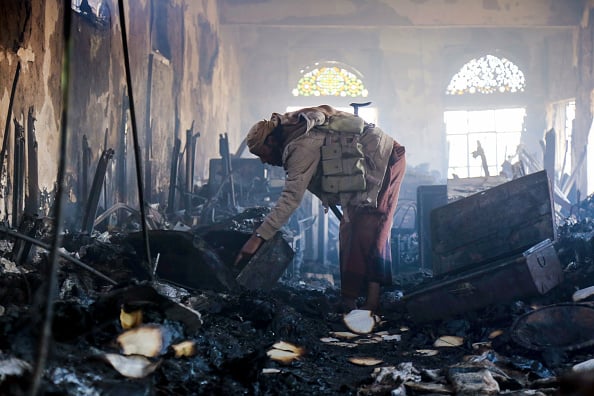Art World
Taiz National Museum Destroyed in Yemeni Civil War
Houthi rebels and resistance fighters have blamed each other.

Houthi rebels and resistance fighters have blamed each other.

Henri Neuendorf

The Taiz National Museum, located in the southern city of Taiz in Yemen, has been destroyed in a fire caused by shelling from Houthi rebels, destroying the building and the majority of its historic contents.
The museum housed items belonging to the last Yemeni Imam, Ahmed Hamid Al-Deen, as well as 1,000-year old manuscripts and copies of the Koran. Artifacts, such as a ceremonial Turban belonging to an ancient ruler and a pair of pistols, have all succumbed to the flames.
According to the BBC, civil war broke out in Yemen in 2014 after rebels joined troops loyal to a former president to form a fighting force known as the Houthis. Together, the fighters captured large portions of territory including the Yemeni capital, Sanaa, causing the internationally recognized government to retreat to the southern port city of Aden.
Located 330 kilometers south of the capital, Taiz is Yemen’s third-largest city and is held by a group of resistance fighters loyal to the internationally recognized government.
Citing UN sources, the Daily Mail reported that the conflict has resulted in significant damage to Yemen’s historic sites and monuments, including the ancient Ottoman-era al-Owrdhi complex outside of Sanaa’s old city.
In a statement released in June 2015, UNESCO Director-General Irina Bokova said she was “profoundly distressed” by the cultural destruction in Yemen. “This destruction will only exacerbate the humanitarian situation and I reiterate my call to all parties to respect and protect cultural heritage in Yemen,” she urged.

Sanaa, capital of Yemen.
Photo: Rod Waddington via Wikipedia.
Justifying the attack on the museum, an unnamed Houthi leader speaking to the Middle Eastern Eye accused the resistance of using the museum as a military base.
“The resistance is responsible for burning the museum as the fighters of the resistance targeted the Houthis from the museum,” he said. “Most of the Houthis fighters are originally from Taiz province, and the history of Taiz is their history, and no one wants to destroy his history himself,” he added.
However, a resident living in the vicinity of the museum said the attack was unprovoked.
“The Houthis started to target the museum four days ago and they still have not stopped,” the witness claimed. “I saw vehicles of the resistance enter and leave the yard, but the resistance did not fire on the Houthis from our neighborhood,” he said.
Mamoon Mohammed, a history professor at Taiz University admitted that both sides must accept responsibility for the museum’s destruction, and urged fighters to avoid targeting places of cultural and historic significance.
“The resistance made the mistake of putting their military vehicles in the museum, but this is not enough of an excuse for the Houthis to target the museum.”
“By targeting the historical places, the warring sides are going to kill our history, and that is why I am calling [on] the warring sides to refrain from fighting in Yemen’s historical places,” he said.